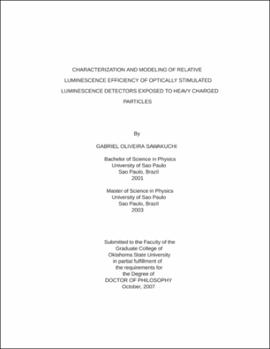| dc.contributor.advisor | Yukihara, Eduardo G. | |
| dc.contributor.author | Sawakuchi, Gabriel Oliveira | |
| dc.date.accessioned | 2013-11-26T08:26:36Z | |
| dc.date.available | 2013-11-26T08:26:36Z | |
| dc.date.issued | 2007-10 | |
| dc.identifier.uri | https://hdl.handle.net/11244/6912 | |
| dc.description.abstract | Scope and Method of Study: This work investigates the optically stimulated luminescence (OSL) response of carbon-doped aluminum oxide Al2O3:C detectors exposed to heavy charged particles (HCPs) with energies relevant to radiation protection in space, and cancer therapy. This investigation includes ground-based experiments in accelerators and theoretical studies of the detector's response. These theoretical studies are based on the track structure model (TSM) and require information of the spatial pattern of energy deposition around the HCP path - the radial dose distribution (RDD). Thus, RDDs were obtained using six analytical models, and Monte Carlo (MC) simulations with the code GEANT4. In addition, we propose a modified analytical model to improve the agreement between calculated and experimental efficiency values. | |
| dc.description.abstract | Findings and Conclusions: Dose response experiments showed that beta rays and H 1000 MeV radiations produced similar responses in the detectors and we concluded that the H 1000 MeV and beta radiations deposit energy similarly. We observed a common trend of decreasing the relative luminescence efficiency as increasing the unrestricted linear energy transfer in water (LET in water) for all the detectors. For Luxel TM detectors the relative luminescence efficiency was close to unit for particles with LET in water lower than 3 keV/micrometer. TSM using the RDD from Chatterjee and Schaefer, Butts and Katz, Waligorski et al., Fageeha et al., Kiefer and Straaten, and Geiss et al. models failed to predict the relative luminescence efficiency values. We proposed a modified version of the RDD from Butts and Katz model, which agreed within 20 % with relative luminescence efficiency experimental data. This was the first time that such agreement was achieved for a wide range of HCPs of different energies. MC simulations with GEANT4 agreed within 35 % with relative luminescence efficiency experimental data. Finally, we suggested a correction method, based on the calculation of the relative luminescence efficiency using the TSM presented in this dissertation, to measure more reliable absorbed doses when using luminescence detectors in complex radiation fields. | |
| dc.format | application/pdf | |
| dc.language | en_US | |
| dc.rights | Copyright is held by the author who has granted the Oklahoma State University Library the non-exclusive right to share this material in its institutional repository. Contact Digital Library Services at lib-dls@okstate.edu or 405-744-9161 for the permission policy on the use, reproduction or distribution of this material. | |
| dc.title | Characterization and modeling of relative luminescence efficiency of optically stimulated luminescence detectors exposed to heavy charged particles | |
| dc.contributor.committeeMember | McKeever, Stephen W. S. | |
| dc.contributor.committeeMember | Babu, Kaladi S. | |
| dc.contributor.committeeMember | Melcher, Ulrich | |
| osu.filename | Sawakuchi_okstate_0664D_2492.pdf | |
| osu.accesstype | Open Access | |
| dc.type.genre | Dissertation | |
| dc.type.material | Text | |
| dc.subject.keywords | carbon doped aluminum oxide | |
| dc.subject.keywords | radiation dosimetry | |
| dc.subject.keywords | track structure theory | |
| dc.subject.keywords | monte carlo | |
| dc.subject.keywords | radial dose distribution | |
| thesis.degree.discipline | Physics | |
| thesis.degree.grantor | Oklahoma State University | |
